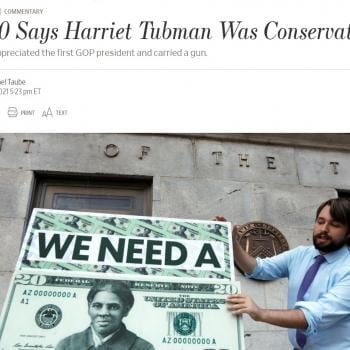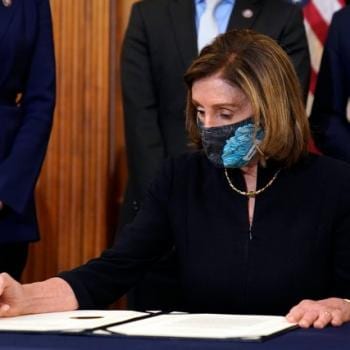As far as I can tell, it all started with a Daily Caller article:
House Speaker Nancy Pelosi sought to include a potential way to guarantee federal funding for abortion into the coronavirus economic stimulus plan, according to multiple senior White House officials.
The article continued as follows:
Speaking to the Daily Caller, those officials alleged that while negotiating the stimulus with U.S. Treasury Secretary Steve Mnuchin, Pelosi tried to lobby for “several” provisions that stalled bipartisan commitment to the effort. One was a mandate for up to $1 billion to reimburse laboratory claims, which White House officials say would set a precedent of health spending without protections outlined in the Hyde Amendment.
…
“A new mandatory funding stream that does not have Hyde protections would be unprecedented,” one White House official explained. “Under the guise of protecting people, Speaker Pelosi is working to make sure taxpayer dollars are spent covering abortion — which is not only backwards, but goes against historical norms.”A second White House official referred to the provision as a “slush fund” and yet another questioned “what the Hyde Amendment and abortion have to do with protecting Americans from coronavirus?”
These “exclusive” Daily Caller interviews with senior White House officials started rumors that the coronavirus relief bill—officially known as the Families First Coronavirus Response Act—contained $1 billion in abortion funding. The right-wing media quickly ran with it.
Tony Perkins of the Family Research Council wrote as follows:
Congress’s coronavirus bill was supposed to be about saving lives — not taking them! But tell that to Speaker Nancy Pelosi (D-Calif.), who doesn’t seem to mind exploiting a global tragedy to help out her pals at Planned Parenthood. Turns out, while Democrats are bashing the president for not working fast enough, they’re bogging down the debate with secret language on abortion.
… Not only is blowing a hole in the Hyde amendment the surest way to stop progress, it’s also the best way to out themselves as hypocrites. “Pelosi wanted to sneak in a billion dollars in funding for abortion programs through the coronavirus stimulus package. Don’t ever tell me the Democrats aren’t politicizing this situation,” Human Rights editor Ian Cheong argued.
(Ian Cheong, is the editor of Human Events, not Human Rights. Cheong was involved in Gamergate, although I can’t figure out how. I did learn that he got caught making anti-semitic comments. He was previously at the Daily Caller, and now writes for various right-wing publications. He also has a google problem.)
Before we look at what was actually in the bill, it’s worth noting that writers at left-wing publications responded to conservative’s claims with articles of their own, warning that Republicans were trying to “sneak abortion restrictions into the coronavirus bill.” An article in Mother Jones explained as follows:
Congress passed the Hyde Amendment in 1976 following the landmark 1973 abortion case Roe v. Wade, as a way of limiting access to abortion in lieu of being able to ban it altogether. Named after Rep. Henry Hyde (R-Ill.0) it forbids federal funding of abortions, which has made it impossible for low income women to receive Medicaid coverage to terminate pregnancies. Because it is an appropriations rider, it has to be renewed every budget cycle. In the 2020 presidential primary campaign former Vice President Joe Biden was criticized by reproductive rights activists after he refused to say he would push to get rid of it as president; he since has reversed his position and said he would supportrepealing it.
Conservative lawmakers have argued that by not including the Hyde amendment in the coronavirus spending package Democrats are trying to invalidate current federal spending bans on abortion, and allow this new funding to pay for abortion services. However, Kelsey Ryland, Director of Federal strategies for All above All, an organization focused on dismantling Hyde and expanding access to abortion, explains that simply isn’t how getting rid of Hyde would work. “I wish it was that easy. it’s a little mind-boggling to me,” Ryland says adding,”I have a hard time seeing how this bill would undue FY2020 appropriations bills that already passed.”
On Twitter, abortion rights activists expressed dismay, warning that by falsely claiming that the bill would fund abortions, Republicans were actively blocking much needed coronavirus relief.
Despite the furor, the issue was resolved rather quickly. Faced with Republican assertions that the bill would fund abortions—assertions that, whether true or not, promised to hold up much needed relief—Pelosi okayed adding Hyde amendment language to the bill:
On Friday, Pelosi and Mnuchin spoke no fewer than 13 times by phone as they neared an agreement, aides said.
To get there, they had to iron out a small handful of stubborn wrinkles that threatened to sink the entire package — disagreements that were finally resolved late Friday evening.
Republicans, for instance, had insisted on the inclusion of language, known as the Hyde Amendment, explicitly barring the use of federal funds for abortions. Democrats conceded and threw it in.
If Pelosi was trying to sneak abortion funding into the coronavirus relief bill, she was more than willing to give up this funding to gain Republican support for the legislation.
Pelosi, in case you’re wondering, was not trying to speak abortion funding into the bill. Because this briefly became such a big deal, I decided to take a close look at what the bill actually said.
Part of this comes down to trust. Those on the right will believe the Family Research Council when they say the bill would have funded abortions. Those on the left will believe Mother Jones when it quotes abortion rights activists explaining that this was absolutely not what happened. It’s exactly because this breaks down to who one trusts that I decided it was worth taking a look at the bill itself.
Funny Numbers
Before I turn to the bill, I want to be very clear that the numbers thrown around in right-wing media were utterly ridiculous from the outset. Even if the Hyde Amendment were repealed, it would take decades to add up to $1 billion in federal monies being used for abortions. The idea that the coronavirus relief bill included $1 billion in abortion funds was always and from the beginning utterly, completely, absolutely ridiculous.
Let’s do the math. At $500 per procedure, $1 billion is enough money to fund 2 million abortions. However, fewer than a third that number are performed in the U.S. each year. In other words, $1 billion would pay for every abortion performed for three years. And remember—Medicaid, which is what we’re talking about when we talk about the Hyde Amendment, only covers low income women.
Let’s assume that half of women who obtain abortions are on Medicaid, which seems high. That’s roughly 300,000 abortions a year. At that rate, it would take six years for this to add up to $1 billion.
But there’s another issue! 33 states have Hyde Amendment language on their books, meaning that abortions performed in these states would not be eligible for Medicaid funding even the federal Hyde Amendment were repealed. This cuts things in half again, meaning that it would now take 12 years to add up to $1 billion.
We’re still not done! The federal government only reimburses around half of all Medicaid expenses. States are expected to cover the rest themselves. That means we have to cut our numbers in half again.
If the Hyde Amendment were repealed, it would take at least 24 years for $1 billion in federal money to be spent on abortions. The idea that the coronavirus relief bill could possibly include $1 billion in funding for abortions is utterly preposterous; this should have been immediately evident to anyone reading this claim.
What the Bill Actually Said
With this out of the way, let’s look at the bill. The majority of the Families First Coronavirus Response Act was not actually about funding for medical expenses at all. Here’s the summary of the bill included on Congress’ legislative webpage:
Families First Coronavirus Response Act
This bill responds to the coronavirus outbreak by providing paid sick leave and free coronavirus testing, expanding food assistance and unemployment benefits, and requiring employers to provide additional protections for health care workers.
Specifically, the bill provides FY2020 supplemental appropriations to the Department of Agriculture (USDA) for nutrition and food assistance programs, including
- the Special Supplemental Nutrition Program for Women, Infants, and Children (WIC);
- the Emergency Food Assistance Program (TEFAP); and
- nutrition assistance grants for U.S. territories.
The bill also provides FY2020 appropriations to the Department of Health and Human Services for nutrition programs that assist the elderly.
The supplemental appropriations provided by the bill are designated as emergency spending, which is exempt from discretionary spending limits.
The bill modifies USDA food assistance and nutrition programs to
- allow certain waivers to requirements for the school meal programs,
- suspend the work requirements for the Supplemental Nutrition Assistance Program (SNAP, formerly known as the food stamp program), and
- allow states to request waivers to provide certain emergency SNAP benefits.
In addition, the bill requires the Occupational Safety and Health Administration to issue an emergency temporary standard that requires certain employers to develop and implement a comprehensive infectious disease exposure control plan to protect health care workers.
The bill also includes provisions that
— establish a federal emergency paid leave benefits program to provide payments to employees taking unpaid leave due to the coronavirus outbreak,
— expand unemployment benefits and provide grants to states for processing and paying claims,
— require employers to provide paid sick leave to employees,
— establish requirements for providing coronavirus diagnostic testing at no cost to consumers,
— treat personal respiratory protective devices as covered countermeasures that are eligible for certain liability protections, and
— temporarily increase the Medicaid federal medical assistance percentage (FMAP).
There’s a lot in this bill about food assistance, paid sick leave, and unemployment benefits. There’s even information about safety steps companies need to take to protect their employees from contagion. Only the last section of the bill deals with healthcare expenditures.
With this out of the way, let’s go through the various claims floating around right-wing media last week one by one.
Claim 1: COVID-19 Testing Funding Could be Used for Abortions
I spent a long time combing through the testing section, which is sizable given that it has to address both those with insurance and those without. I double checked to make sure that all funding was explicitly earmarked for COVID-19 testing, and it is. None of it is discretionary. It is all only for COVID-19 testing.
The headings in this section read “Coverage for testing for COVID-19,” “Waiving cost sharing under the Medicare program for certain visits relating to testing for COVID-19,” and so forth. Absolutely everything is about COVID-19 testing.
The Daily Caller article that started the whole conversation claim that the mandate for reimbursement of laboratory claims could be used for funding abortions. This is simply false. Money for COVID-19 testing was set aside for COVID-19 testing only. It wasn’t discretionary and could never be used for abortion.
Claim 2: Violence Against Women Act Provisions Could Fund Abortions
“The White House believes provisions in the Pelosi bill that pertain to the Violence Against Women Act could open the door to federal funds for abortion,” one news source reported. I looked into this, and it is also completely false.
The only time the Violence Against Women Act was mentioned in the initial bill was in defining sexual assault, domestic violence, and stalking. Why were those defined? Because a section of the paid sick leave portion of the bill allowed women to take paid leave when seeking relief from such violence (court proceedings, etc.).
Pelosi ultimately removed all of the above during the negotiation process in order to get the bill to a place where Republicans would support it. In fact, the bill no longer creates any permanent paid sick leave provision. Instead, it only creates (limited) paid sick leave for the COVID-19 outbreak and the COVID-19 outbreak only.
Claim 3: The Additional Medicaid Funding Could Be Used for Abortions
This leaves one final claim, tied to the bill’s inclusion of additional Medicaid funding for the states. Because the section on this funding did not include Hyde Amendment language, the argument went, states were not prohibited from using these federal Medicaid reimbursements to fund abortions. (See claims on Twitter).
Note that this is not a claim that the bill snuck in funding specifically for abortion (anyone who claimed that was completely making shit up). Instead, the claim at issue here is that states could, in absence of Hyde Amendment language, seek Medicaid reimbursements from the federal government for abortions obtained by low-income women covered by Medicaid. In other words, the concern was that the bill would undo the Hyde Amendment.
What does the bill actually do? It contains a temporary 8% increase in the federal match for Medicaid spending (ordinarily, the federal government reimburses states for 50% to 77% of their Medicaid expenditures depending on the state’s per-capita income—less monied states get a higher federal reimbursement level):
SEC. 109. TEMPORARY INCREASE OF MEDICAID FMAP.
(a) In General.—Subject to subsection (b), for each calendar quarter occurring during the period beginning on the first day of the emergency period defined in paragraph (1)(B) of section 1135(g) of the Social Security Act (42 U.S.C. 1320b–5(g)) and ending on the last day of the calendar quarter in which the last day of such emergency period occurs, the Federal medical assistance percentage determined for each State, including the District of Columbia, American Samoa, Guam, the Commonwealth of the Northern Mariana Islands, Puerto Rico, and the United States Virgin Islands, under section 1905(b) of the Social Security Act (42 U.S.C. 1396d(b)) shall be increased by 8 percentage points.
It is absolutely the case that this bill would increase federal Medicaid reimbursement rate for all medical expenses overall, not just for medical expenses related to COVID-19. It is also true that this bill did not include Hyde Amendment language. But even this claim ultimately fails to make its case.
Why This Claim Fails
First, let’s do the math. Imagine that a state regularly spends $1 million on healthcare for its low income population. Through Medicaid, the state can receive reimbursements for 50% of those expenses. This means that the state ends up on the hook for $500,000 in costs for healthcare for its low income residents in any given year.
Now imagine that the COVID-19 pandemic doubles the amount the state has to spend on healthcare for its low income population. Under this bill, the state would receive a a federal reimbursement for 58% of those expenses, instead of its regular 50%. This means the federal government will provide $1,116,000 in reimbursements. That’s a lot more than the $500,000 reimbursement the state would have revived without COVID-19!
But remember, the overall cost of healthcare for the state’s low income residents also went up. The state is now on the hook for $840,000. That’s better than the $1 million it would have been on the hook for without this relief bill, but it’s still higher than the $500,000 it would have spent in the absence of the COVID-19 pandemic.
In other words, states are not suddenly going to have extra money on their hands. Instead, the increased reimbursement rate in the relief bill is designed to offset part of the increased medical costs states will incur due to COVID-19, in the hope that this added flexibility will help states’ budgets stretch further.
Just so we’re clear about what Medicaid covers:
Medicaid covers nursing home care and other long-term services and supports, as well as other medical care and supportive services that Medicare doesn’t cover, which help many low-income seniors and people with disabilities stay independent and healthy.
The elderly (low income or not) are the population COVID-19 will hit the hardest, along with people with disabilities that leave them immunocompromised. States are going to be accruing a whole lot more Medicaid expenses due to this pandemic. The increased Medicaid percentage match will help, but state budgets are still going to end up stretched thin. There’s not going to be a bunch of extra extra money to throw at abortions.
But this isn’t the only issue!
The second problem with right-wing claims that this funding could be used for abortion is that the Hyde Amendment still applies to Medicaid funding provided in the FY2020 appropriations bill. To return to our example above, the initial 50% federal Medicaid reimbursement could not be used for abortions. Increasing the federal Medicaid reimbursement from 50% to 58% does not change the rules that cover that first 50%.
Here, have a look:
Sec. 506
(a) None of the funds appropriated in this Act, and none of the funds in any trust fund to which funds are appropriated in this Act, shall be expended for any abortion.
None of the funds appropriated in the FY2020 appropriations bill can be used for abortions. Increasing the federal Medicaid reimbursement percentage from 50% to 58% does not change the limits placed on funds appropriated in the FY2020 appropriations bill. Could states try to get the federal government to provide a reimbursement for 8% of the money they spent covering abortions for low-income women? In theory, but in practice I don’t think it actually works like that. Let me see if I can explain.
For states to request abortion funding reimbursements under the increased Medicaid allotment that is not subject to the Hyde Amendment, there would need to be a process that would allow states to ask for reimbursement for just 8% of an expense incurred. I highly doubt such a process exists.
In practice, I suspect the restrictions set on Medicaid funding in the FY2020 appropriations bill would apply across the board, grandfathered in to the increased rate. Increasing the Medicaid reimbursement rate does not change the fact that federal law says Medicaid funding cannot be used for abortion. The idea that this bill would have resulted in any federal money going toward abortion expenses at all is bizarre.
I want to make one final point. Let’s imagine for a moment that the initial absence of Hyde Amendment language in the bill was an actual problem—that the bill in theory could have resulted in federal funding for abortion. In this case, you have to assume Pelosi was acting in extraordinarily bad faith to believe she set out to intentionally slip abortion funding into this bill. In this circumstance, what would be more likely? That she tried to hide abortion funding in the bill? Or that it didn’t occur to her that abortion was relevant to this bill to begin with?
If I were drafting a bill to provide medical funds in the midst of a global pandemic, I highly doubt it would occur to me that the bill needed to state that these funds could not be used for abortions. Granted, I’m not Nancy Pelosi, but even if this were an actual problem, it feels much more like an oversight than connivery.
Note, too, that as soon as Republicans told Pelosi they wanted Hyde Amendment language included in the bill, she acquiesced. To me, that suggests that this bill was never about abortion funding for her to begin with. What is more likely? That Pelosi was trying to put abortion funding in the coronavirus relief bill, or that it didn’t occur to her that it needed to be explicitly stated that this funding was not for abortions?
If some Republicans were concerned that the bill, by not containing Hyde Amendment language, created an infinitesimal possibility that some funds could be used for abortions, they could have simply approached Pelosi about their concern. An initial bill is often an opening offer. That’s why Pelosi included permanent paid leave. All concerned Republicans had to do was tell Pelosi they wanted to add Hyde Amendment language.
Instead, we got a ridiculous public fear mongering campaign falsely claiming that Pelosi had hidden a billion dollars in abortion funding in the coronavirus relief bill. This is bad because it temporarily turned a substantial portion of the population against a bill that was desperately needed, in the midst of a global pandemic.
In Conclusion
Pelosi didn’t make this political. Republicans did. And when they did, Pelosi let them stick their completely unnecessary anti-abortion language in the bill. You know why? Because she was more interested in passing a desperately needed bill than she was in playing games. That’s the opposite of politicizing the situation.
I have a Patreon! Please support my writing!















